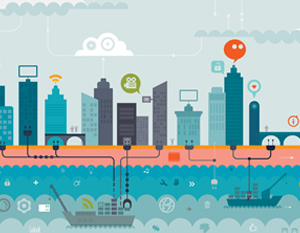A recent article in CIO Insight, The Internet of Things Gets Real, reveals remarkable statistics projecting the IoT’s growth. “According to Cisco Systems, 99 percent of physical objects will eventually become part of a connected network. Meanwhile, consulting firm Gartner predicts that IoT products and service suppliers will generate incremental revenues exceeding $300 billion by 2020. It also estimates an almost 30-fold increase in the number of connected devices from 2009 to 2020, when there will likely be somewhere around 26 billion connected devices in homes and businesses.”
McKinsey’s latest IoT study, out this month, states that IoT has a total potential economic impact of $3.9 trillion to $11.1 trillion a year by 2025. They go on to extrapolate that this is 11% of the world economy. Even the less optimistic forecasts are enormous. On June 2nd, research firm International Data Corp said the global market for IoT, will nearly triple to $1.7 trillion by 2020 and that the IoT market, valued at $655.8 billion in 2014, is set to grow at a compounded annual rate of 16.9%.

It’s not hype. It’s not marketing hubris. Even if it’s a bubble, it’s real, it’s in its infancy and it’s here to stay. But as we are fond of saying at Gotransverse, “if you can’t bill for it, it’s a hobby or a remarkably expensive learning process.” So what does it take to monetize the IoT revolution (or as Newsweek calls it the “Fourth Industrial Revolution”)?
IoT is already having a significant impact on the creation of new products and services across a number of verticals including telecom, transport and location based services, utilities, industrial, healthcare and many, many more. Each one of these new business models and their connected devices are producing valuable usage that tracks how customers are consuming products and services. Advanced cloud based billing not only allows rapid time-to-market, but if it allows bundling of subscriptions and the critical ability to meter, rate and dynamically price these usage events, you start to realize the full potential of the IoT and the return of investment for you, your customers and your IoT partner ecosystem. Considerations for billing include:
- Rapid and dynamic provisioning of devices: requires advanced RESTful APIs and the critical ability to manage metering and entitlements.
- Usage or “consumption” based billing: Your customers will want to be able to pay for what they consume. This can’t be effectively done without the ability to “rate” in as real time as possible each and every event that is to be monetized. This rating capability also allows important tiered and tapered pricing and the pooling of events (similar to a family plan and the ability to share or carry-over of event bundles/buckets to the next pay period).
- Customer communication and self service: Your customers will want to be able to review their consumption and billing charges. They will also want to manage basic parameters of their account without an expensive reach into a contact center.
- Support new business models and react quickly to the market. You shouldn’t have to go back to your billing provider to launch a new product or service.
Whether the IoT is hype your not, it is likely that either you or your customers will need to be ready to profit from it.
Read about more important considerations in our free whitepaper: Buyer Be Aware.
Contact Gotransverse today for a professional consultation.

 James
Messer
on
Jul 02, 2015
James
Messer
on
Jul 02, 2015